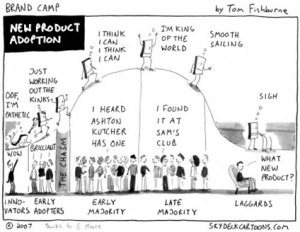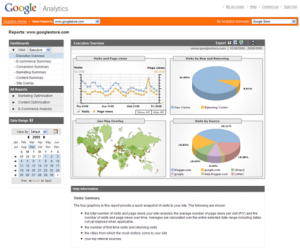How to Generate the First Customers for our New Online Startup?

At the time of starting –as also happened to us—, most of the founders of an Internet startup focus primarily on the server’s technology, database and graphic interface.
We really believe that, as our work is going to be brilliant, users will love to come by themselves.
Unfortunately this statement is far from reality; the discipline for thinking of a strategy in order to generate new customers is just as important to succeeding like any other aspect of business.
No matter how spectacular our online development is: unless we have visitors and customers, it is not worth it.
Next, I would like to share a step-by-step guide on how we did with our own business, which had 0 (zero) users at the beginning and which today has more than 21,500,000 customers in Latin America.
It is physical work.
Let’s first focus on understanding that Google, Facebook, Yahoo! and many others companies began just with one (1) single user, his first visitor (not a million of them.)
Then they started having a community of stakeholders, let’s say about 10, 20 or 50 of them, generally called “Early Adopters”. Those users are the ones that have a key effect on the future growth of the project; they will, by their own choice, spread the word.
At that early stage, we were in the first two steps as can be seen in the picture above.
I personally consider that those are the most important links and, what is more, they are the ones that pose more difficulty in any new startup.
It is fundamental to realize that this phase has as priority to understand our future customers and not thinking about how we are going to reach one million users.
Spending three months of our time in getting to know the typical customer was the first concrete step for us. That means that we showed them our development and sat beside them and watched as they used our system (without interrupting!). We pay attention to their reactions, questions, opinions, criticisms, and suggestions.
Though simple as it may seem, there is nothing that is more valuable than a face to face and personal experience with the potential clients. They could be family, friends, acquaintances or simply users that seem to have our development profile and agree to give us a few minutes of their time.
This first step shouldn’t be done by email, telephone or any other way which is not personal. As the famous entrepreneur Paul Graham said, “You have to leave the office in order to really meet clients.” I recommend following him on his blog, which is priceless: PaulGraham.com.
Use personal media.
Once we have spent three months in direct contact with customers, a process in which we were substantially improving our initial proposal as we learned from them (no one knows more about the customer needs than themselves!), we can move to the second step.
This second stage consist in taking advantage of our email box, Facebook and Twitter profile, in addition to any other media such as Whatsapp, and Line, among others.
It is important to highlight that I am not saying that making indiscriminate contact with an equal treatment is the best option (usually people realize and that subtracts value considerably); the message we want to transmit can be more or less the same in each case, but it must include the receiver’s name, and it must also be concise and personal. For example:
“Hi Diego,
We just finished developing a new online application that will help you find a cheaper travel ticket for holidays.
You can try it in the link that I sent you, and then you could, if you want, tell us your experience in order to continue improving the application. Your help is really valued for us Diego.
Thank you and have a nice day!”
The shorter the message, the better; I remember that we wrote a very long text for our website (as if it were a statement explaining even how the application worked in a technological way), we sent it and sincerely the results were very poor. After that we tested with two lines of text and it was substantially better.
Results measurement.
On this step of generating new customers, as in all the following ones, we cannot estimate how well or badly we are doing our job; from now on we need specific measurements.
For that reason I recommend using Google Analytics, which is a free tool, easy to install and use. It will help us to measure the traffic of people that access our site, their behavior and the end results.
For example, if our site is called www.mystore.com.ar, when we send a link, as we saw in the previous step, we can add a parameter (at the end of the URL we can add a question mark and some values) in order to know if this user does actually access our project and try it. Example with parameter: www.mystore.com.ar?usuario=diego
Also, if we want to know which media (facebook, twitter, whatsapp, to mention some) is generating better results, we can add another parameter with with & where we define value. For example: www.mystore.com.ar?usuario=diego&.... This is Diego, who came through Facebook.
It is not touch-and-go.
We should understand that maybe in the moment that we sent our message the user was in a meeting, on vacation or simply could not use our application, product/service at that moment.
That is why we must know who uses our service and who does not from the above mentioned step onwards. Being able to contact them with a very brief message to invite them again to try our development is important; it also valuable to ask for their opinion and criticism to continue improving.
“Hi Diego!
We are contacting you again in order to see if you want to help us with your experience and knowledge in this project that is very important to us through this link.
Since now we thank you Diego sincerely for your comments.
Thank you. “
You will be surprised by the answers that this second email may receive, as we continue contacting the user (friend, relative or acquaintance) by name and also monitor; demonstrating that his/her opinion is important to us. Just try it and you will be able to check it. Between the first and second email there has to be a period of 4 to 6 days’ time.
We should always thank the response to these emails.
Once we had performed the steps described in this article successfully, we continued by contacting different Media such as radio, television and newspapers. It was not easy. It took time, but the experience was worth it.
The following step was learning about SEO (Search Engine Optimization), which basically is like working with search engines (Google, Yahoo! and Bing) so that customers may find us when they seek for our service. For example, if we are offering an application that enables the client to find cheaper tickets, when someone searches “Cheap tickets to Mexico” in Google, our startup should appear in the search results.
Even today we continue working with SEO and I can say that that is one of the best ways to bet in the long term at Marketing level. Although there is not a solution to apply in the beginning of a venture in order to attract the first customers, which is why I do not mention this earlier in this note, it takes a lot of time: on average, about 2 to 3 years to see the first results; however, as a mid – long term strategy it is excellent. For more information I suggest using MOZ community, where you can find are interesting free videos and tutorials about this topic.
[image error]





